Mentors & influences
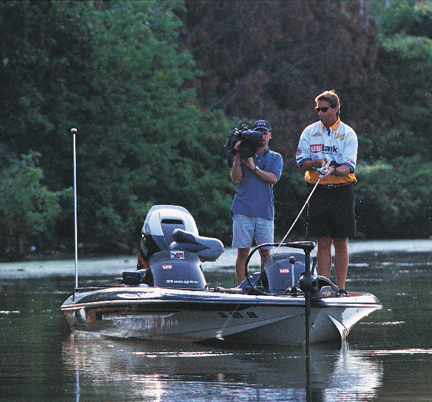
Catalysts in the lives of a few, in turn influence thousands
It could be said that it takes an angler to make an angler. Rarely do people become bass anglers by themselves. Almost anyone who enjoys bass fishing as an avocation or an occupation can recall a fishing expert or two who helped him get started.
Fathers or immediate family members are often responsible for putting the first fishing rod in a youngster’s hands. Friends and neighbors who have bass boats play a key role in spreading the bass-fishing bug. Bass club members are particularly known for being benefactors to those who are eager to learn more about fishing.
Whether they are referred to as mentors, influences or inspirations, these are the folks who ignite the spark or add fuel to the fire of a beginning bass angler’s obsession.
Today’s top bass pros have many such influential people in their past. Here is a look at the mentors and influences of a few well-known pros.
Bernie Schultz
“I would have to say that anybody I have ever fished with has been a mentor,” said Gainesville, Fla., pro Bernie Schultz. “In some way I have learned a little something from them all.”
Though Schultz does not claim to have one distinct mentor, he credits Wayne Naramore, his older sister’s former husband, with having a heavy influence on his fishing. When Schultz was a teenager, he fished with Naramore often.
“Wayne taught me a skill that has been invaluable over the course of my career,” Schultz said. “He taught me the importance of casting accuracy with casting and spinning tackle. More importantly, he showed me the benefits of being able to cast accurately, right- or left-handed.”
Naramore schooled Schultz on the finer points of ambidextrous casting by proving to him that having to switch hands after each cast was inefficient. “He proved to me that every time you switch hands with the rod after a right-handed cast, valuable time and bait contact is lost in the exchange,” Schultz said. “I forced myself to learn how to cast left-handed early in my career, and it was one of the best things I did. Being ambidextrous allows you to cast in reverse angles, and that more than doubles your casting opportunities.”
Larry Nixon
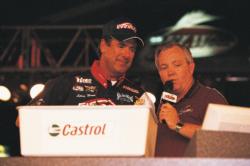 Larry Nixon’s reputation as an offshore structure wizard did not happen by accident. In the late ’60s, the Bee Branch, Ark., native was taught by one of structure fishing’s pioneers, Lou Matlock.
Larry Nixon’s reputation as an offshore structure wizard did not happen by accident. In the late ’60s, the Bee Branch, Ark., native was taught by one of structure fishing’s pioneers, Lou Matlock.
“Lou was structure fishing before there was such a thing as structure fishing,” Nixon said.
Lou Matlock, along with names like Glen Andrews and Bill Dance, was considered to be one of the great fishing guides of his time. He had a guide business on Greers Ferry Lake in Arkansas and helped Nixon get his own guide business started. “He would refer guide work to me when he had too many clients,” Nixon said. “For about eight years I fished with him every opportunity I could.”
Nixon remembers a time before depth finders when Matlock probed the lake with an anchor and a rope.
“He would get out there and bounce an anchor around looking for underwater breaks and points,” Nixon said. “We did not know where the fish went when they left the bushes, but he did. He would get out there and find whole populations of structure bass that had never seen a lure.”
Nixon said that Matlock was the first angler he knew of to buy a “green box,” or depth finder. “Once he got that depth finder and could see what he was fishing, he really schooled me on structure fishing,” Nixon said.
David Fritts
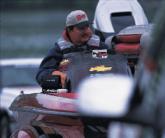 David Fritts of Lexington, N.C., is known as professional bass fishing’s crankbait king. Though he learned a lot of his craft through trial and error, he did have a “partner in cranking.”
David Fritts of Lexington, N.C., is known as professional bass fishing’s crankbait king. Though he learned a lot of his craft through trial and error, he did have a “partner in cranking.”
“I never had anybody take me out there and say, `This is the best crankbait, this is the best rod for a crankbait, this is the best water to throw a crankbait on,'” Fritts said. “I learned a lot of that stuff on my own, but one who helped me tremendously in that learning process was Jerry Lohr. Jerry was my team partner on the Carolina circuits for eight years.”
Fritts said that Lohr had the same kind of fascination with crankbaits and deep structure as he did. The two anglers spent countless hours in the boat discovering and fine-tuning deep-water crankbait fishing.
“We were always competing against other great structure fishermen like Abe Abernathy and David Wright,” Fritts said. “That really pushed Jerry and me to learn as much as we possibly could.”
Gary Klein
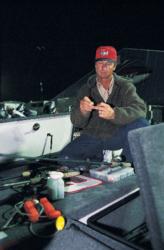 In 1974, western fishing legend Dee Thomas had just collected a routine tournament-winning check on his home lake when 15-year-old Gary Klein approached him and said, “Wow, that was neat. Just think, if I had been fishing that tournament, I could have beat you.”
In 1974, western fishing legend Dee Thomas had just collected a routine tournament-winning check on his home lake when 15-year-old Gary Klein approached him and said, “Wow, that was neat. Just think, if I had been fishing that tournament, I could have beat you.”
Instead of being insulted, Thomas was amused by young Klein’s reaction to witnessing his first bass tournament. In fact, that initial quip from Klein sparked a five-year fishing apprenticeship and a lifelong friendship.
“Dee took me under his wing and really expedited my learning process,” Klein said. “From the time I was 15 until I was 20, Dee taught me how to read water, the critical aspects of boat positioning and the intricacies of shallow-water flipping.”
While Klein was studying the skinny water with Thomas, he was also receiving expert instruction in the deep end with western deep-water wizard Mike Folkstead.
“Mike was a tremendous influence on my fishing as well,” Klein said. “I spent countless weekends with him on Lake Mead and Havasu learning deep-water techniques. I really credit Mike with teaching me how to interpret electronics.”
Klein said that both Thomas and Folkstead represented the forefront of their respected strengths. “They were on the cutting edge of fishing technology – rods, reels, boats, motors, trolling motors, electronics – they ran everything up the flagpole to give it a try. They were way ahead of their time, and that helped me tremendously when I turned pro.”
Speaking of turning pro, Klein credits lure designer Rich Forhan for giving him the courage to move to Texas to try competitive fishing for a living. “Rich encouraged me to live my dream,” Klein said. “He told me, `You are already in debt. What’s the worst that could happen to you? More debt?'”
With those words, Klein threw caution to the wind and moved to Texas to pursue a career in professional bass fishing. He now resides in Weatherford, Texas.
David Walker
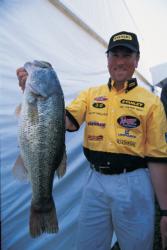 David Walker of Sevierville, Tenn., said he had different influences at various stages in his bass-fishing education and career. His interest was sparked as a youngster by casting Rapalas and Jitterbugs from the banks of Pontiac Lake in Michigan alongside his father and uncle.
David Walker of Sevierville, Tenn., said he had different influences at various stages in his bass-fishing education and career. His interest was sparked as a youngster by casting Rapalas and Jitterbugs from the banks of Pontiac Lake in Michigan alongside his father and uncle.
In 1990, Walker moved to Kentucky and joined a bass club to satisfy his bassing cravings. Boatless and yearning to learn, Walker took the approach of “have rods, will travel.”
“Eddie Evans, Charlie Evans’ brother, was in the club, and he told me about a guy who was going to Florida to fish the Operation Bass Golden Blend on Lake Okeechobee,” Walker said. “I wanted to go so badly that I called this guy up out of the blue and asked him if I could hitch a ride. He picked me up at a gas station, and I was off to Florida with a complete stranger.”
That complete stranger turned out to be Bill Taylor, present-day FLW Tour tournament director.
“At the time, Bill was a fishing legend in Kentucky,” Walker said. “He held the record for the most Red Man Tournament Trail victories. From that trip we became friends. Bill taught me a lot about fishing reservoirs and patterning fish on impoundments.”
Jay Yelas
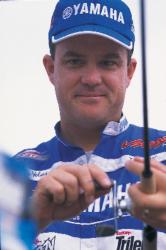 When it comes to discussing mentors, 2002 FLW Tour Angler of the Year Jay Yelas is fervent about his mentor Bill Sedar.
When it comes to discussing mentors, 2002 FLW Tour Angler of the Year Jay Yelas is fervent about his mentor Bill Sedar.
The two anglers met when Yelas was a junior in high school and Sedar was the owner of the local tackle shop in Yelas’ hometown of Santa Barbara, Calif.
Yelas had just discovered bass fishing and wanted to learn more. Sedar was a renowned bass angler in the Santa Barbara area and was considered the “King of Lake Cachuma,” the local lake where he fished five days a week.
Yelas used to peruse Sedar’s tackle shop not so much for tackle but for precious information about bass fishing from Sedar.
The two were a perfect match – Yelas was hungry for fishing knowledge, and Sedar was a bass-fishing expert. Eventually they struck up a solid friendship, then a unique mentorship. Today their relationship is more like family.
“Bill’s wealth of fishing knowledge was immense,” Yelas said. “When I met him, he had fished for 40 years and was fishing five days a week. He mostly fished on Cachuma, and he used a small aluminum boat. His knowledge of bass behavior was so vast, and more importantly, it was real, it was the truth. He taught me about the intangibles of bass fishing – bass habits, migrations, timing, how to target bigger fish versus smaller fish during different seasons. I was extremely fortunate to have such a teacher in my formative years.”
Yelas and Sedar still stay in contact today. Yelas says that Sedar has written him at least once a month for the last 20 years. Despite being 87 years old, Sedar still fishes with Yelas once a year.
“Bill is an awesome teacher,” Yelas said. “Above all, he taught me an unconditional love and enthusiasm for the sport. Even to this day, when we go fishing he talks passionately about what the bass might be doing. I have never seen him get mad or upset just because the fish weren’t biting. Instead, he is always trying to outsmart them and predict their next move. He taught me how to think on the water and how to learn from my mistakes. He is a very upbeat and positive person, and I would like to think that some of that rubbed off on me.”